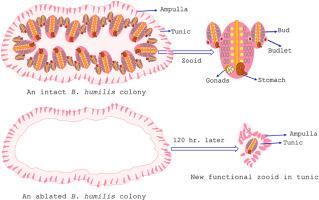卑微的Botryllus:一种有前途的新海鞘模型,用于衰老、干细胞动力学和全身再生。
IF 2.1
3区 生物学
Q2 DEVELOPMENTAL BIOLOGY
引用次数: 0
摘要
模式生物在科学中是必不可少的,因为它们为研究保守的生物过程提供了系统。除了被广泛应用的多细胞和单细胞模式外,被囊动物因其独特的特性而成为生物学领域中有价值的模式生物。作为一种具有有性和无性生殖策略和全身再生能力的脊索动物,被囊动物为再生研究提供了一个独特的系统。虽然大多数生物表现出不同程度的再生能力,但只有少数生物能实现WBR;值得注意的是,botrylid海鞘(Stolidobranchia)是唯一记录在案的具有WBR的脊索动物群。被囊动物是3000多种海洋无脊椎动物的一个亚门,是脊椎动物的近亲。Botryllids包括大约160个Botryllus和Botrylloides属的被囊动物物种,其中不到10个被证明从维管组织中进行了WBR。然而,目前尚不清楚是否所有的botryllids都具有WBR能力。humilis Botryllus最初是在新喀里多尼亚发现的,最近在地中海被发现。本研究首次对黄芽芽孢杆菌在切除所有动物和芽后的胚周期和WBR能力进行了监测。采用两种温度条件和两种分期系统记录胚发生周期。在21°C和38 ppt盐度条件下,菌落在7天内完成成母周期,而在相同盐度条件下,在26°C条件下,这一周期缩短至4天。在胚源周期中,群体年龄似乎影响了出芽动物的数量。本研究还首次通过诱导不同发育阶段的黄芽孢杆菌的WBR来评价黄芽孢杆菌的WBR能力。术后120 ~ 138小时内完成再生,2天内完成再生后的第一个胚源周期。该研究为黄芽孢杆菌作为衰老、干细胞动力学和WBR研究的极有价值的模式物种提供了有价值的见解。本文章由计算机程序翻译,如有差异,请以英文原文为准。

Botryllus humilis: A promising new ascidian model for aging, stem cell dynamics, and whole-body regeneration
Model organisms are essential in science as they provide systems for studying conserved biological processes. In addition to widely used multicellular and unicellular models, tunicates have emerged as valuable model organisms in various biological fields due to their distinctive characteristics. As chordates with both sexual and asexual reproductive strategies and the capacity for whole-body regeneration (WBR), tunicates provide a unique system for regeneration studies. Although the majority of organisms display varying levels of regenerative ability, only a few can perform WBR; notably, botryllid ascidians (Stolidobranchia) are the sole documented group of chordates with WBR. Tunicates, a subphylum of over 3000 identified marine invertebrate species, are the closest living relatives of vertebrates. Botryllids comprise approximately 160 colonial tunicate species within the genera Botryllus and Botrylloides, less than ten of which have been shown to undergo WBR from vascular tissue. However, it remains unknown whether all botryllids are capable of WBR or not. Botryllus humilis was first observed in New Caledonia and has recently been identified in the Mediterranean Sea. In the present study, the blastogenic cycle and WBR capacity of B. humilis were monitored for the first time following the ablation of all zooids and buds. Two temperature conditions and two staging systems were used to record the blastogenetic cycle. Colonies completed their blastogenic cycle in 7 days at 21 °C and 38 ppt salinity, while this duration shortened to 4 days at 26 °C under the same salinity. Colony age appeared to influence the number of budded zooids during the blastogenic cycle. I also assessed the WBR capacity in B. humilis for the first time by inducing WBR at different stages of the blastogenic cycle. Regeneration was completed within 120–138 h post-surgery, and the first post-regeneration blastogenic cycle was completed within 2 days. This study provides valuable insights into B. humilis as a highly valuable model species for aging, stem cell dynamics, and WBR studies.
求助全文
通过发布文献求助,成功后即可免费获取论文全文。
去求助
来源期刊

Developmental biology
生物-发育生物学
CiteScore
5.30
自引率
3.70%
发文量
182
审稿时长
1.5 months
期刊介绍:
Developmental Biology (DB) publishes original research on mechanisms of development, differentiation, and growth in animals and plants at the molecular, cellular, genetic and evolutionary levels. Areas of particular emphasis include transcriptional control mechanisms, embryonic patterning, cell-cell interactions, growth factors and signal transduction, and regulatory hierarchies in developing plants and animals.
 求助内容:
求助内容: 应助结果提醒方式:
应助结果提醒方式:


